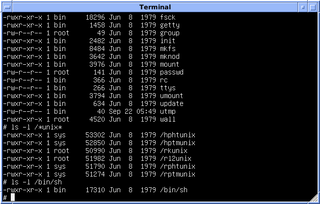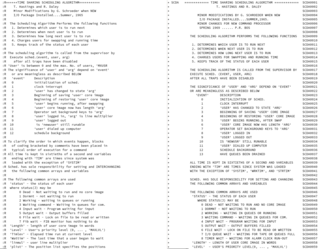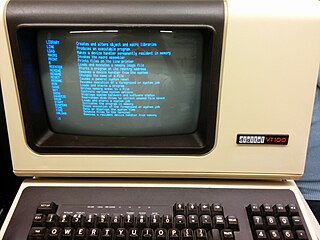Related Research Articles

Multics is an influential early time-sharing operating system based on the concept of a single-level memory. Nathan Gregory writes that Multics "has influenced all modern operating systems since, from microcomputers to mainframes."

A Unix shell is a command-line interpreter or shell that provides a command line user interface for Unix-like operating systems. The shell is both an interactive command language and a scripting language, and is used by the operating system to control the execution of the system using shell scripts.

The Bourne shell (sh) is a shell command-line interpreter for computer operating systems.
In software development, Make is a build automation tool that builds executable programs and libraries from source code by reading files called makefiles which specify how to derive the target program. Though integrated development environments and language-specific compiler features can also be used to manage a build process, Make remains widely used, especially in Unix and Unix-like operating systems.

The Compatible Time-Sharing System (CTSS) was the first general purpose time-sharing operating system. Compatible Time Sharing referred to time sharing which was compatible with batch processing; it could offer both time sharing and batch processing concurrently.
An environment variable is a user-definable value that can affect the way running processes will behave on a computer. Environment variables are part of the environment in which a process runs. For example, a running process can query the value of the TEMP environment variable to discover a suitable location to store temporary files, or the HOME or USERPROFILE variable to find the directory structure owned by the user running the process.
The Control Language (CL) is a scripting language originally created by IBM for the System/38 Control Program Facility and later used in OS/400. It bears a resemblance to the IBM Job Control Language and consists of a set of command objects (*CMD) used to invoke traditional programs or get help on what those programs do. CL can also be used to create CL programs where there are additional commands that provide program-like functionality
In computing, echo is a command that outputs the strings that are passed to it as arguments. It is a command available in various operating system shells and typically used in shell scripts and batch files to output status text to the screen or a computer file, or as a source part of a pipeline.
Command-line completion is a common feature of command-line interpreters, in which the program automatically fills in partially typed commands.

A command shell is a command-line interface to interact with and manipulate a computer's operating system.

In computing, a shell is a computer program that exposes an operating system's services to a human user or other programs. In general, operating system shells use either a command-line interface (CLI) or graphical user interface (GUI), depending on a computer's role and particular operation. It is named a shell because it is the outermost layer around the operating system.

Louis Pouzin is a French computer scientist. He designed a pioneering packet communications network, CYCLADES that was the first to implement the end-to-end principle, which became fundamental to the design of the Internet.

In computing, alias is a command in various command-line interpreters (shells), which enables a replacement of a word by another string. It is mainly used for abbreviating a system command, or for adding default arguments to a regularly used command. alias is available in Unix shells, AmigaDOS, 4DOS/4NT, KolibriOS, Windows PowerShell, ReactOS, and the EFI shell. Aliasing functionality in the MS-DOS and Microsoft Windows operating systems is provided by the DOSKey command-line utility.
In computing, a shebang is the character sequence consisting of the characters number sign and exclamation mark at the beginning of a script. It is also called sharp-exclamation, sha-bang, hashbang, pound-bang, or hash-pling.
A batch file is a script file in DOS, OS/2 and Microsoft Windows. It consists of a series of commands to be executed by the command-line interpreter, stored in a plain text file. A batch file may contain any command the interpreter accepts interactively and use constructs that enable conditional branching and looping within the batch file, such as IF, FOR, and GOTO labels. The term "batch" is from batch processing, meaning "non-interactive execution", though a batch file might not process a batch of multiple data.

In computing, help is a command in various command line shells such as COMMAND.COM, cmd.exe, Bash, qshell, 4DOS/4NT, Windows PowerShell, Singularity shell, Python, MATLAB and GNU Octave. It provides online information about available commands and the shell environment.

A scripting language or script language is a programming language that is used to manipulate, customize, and automate the facilities of an existing system. Scripting languages are usually interpreted at runtime rather than compiled.
In computing, command substitution is a facility that allows a command to be run and its output to be pasted back on the command line as arguments to another command. Command substitution first appeared in the Bourne shell, introduced with Version 7 Unix in 1979, and has remained a characteristic of all later Unix shells. The feature has since been adopted in other programming languages as well, including Perl, PHP, Ruby and Microsoft's Powershell under Windows. It also appears in Microsoft's CMD.EXE in the FOR command and the ( ) command.

A command-line interface (CLI) is a means of interacting with a device or computer program with commands from a user or client, and responses from the device or program, in the form of lines of text. Such access was first provided by computer terminals starting in the mid-1960s. This provided an interactive environment not available with punched cards or other input methods.
Glenda Schroeder is an American software engineer noted for implementing the first command-line user interface shell and publishing one of the earliest research papers describing electronic mail systems while working as a member of the staff at the MIT Computation Center in 1965.
References
- 1 2 Grisman, P.A., ed. (1969). The Compatible Time-Sharing System - A Programmer's Guide, 2nd Ed. Boston: The MIT Press. p. 525.
- ↑ Pouzin, Louis (25 November 2000). "The Origin of the Shell". Multicians. Retrieved 31 July 2017.
- ↑ Pouzin, Louis (April 2, 1965). The SHELL: A Global Tool for Calling and Chaining Procedures in the System (PDF) (Report). Massachusetts Project Institute of Technology Project MAC. MDN-4. Retrieved April 9, 2022.
- ↑ Pouzin, Louis (April 7, 1965). RUNCOM - A Macro-Procedure Processor for the 636 System (PDF) (Report). Massachusetts Project Institute of Technology Project MAC. MDN-4. Retrieved April 9, 2022.
- ↑ "In Unix, what do some obscurely named commands stand for?". IT Knowledge Base. Indiana University . Retrieved 2009-04-20.
- ↑ "Unix and Multics" . Retrieved 2009-04-20.